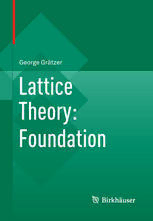
Lattice Theory: Foundation PDF
Preview Lattice Theory: Foundation
George Grätzer Lattice Theory: Foundation George Grätzer Department of Mathematics University of Manitoba Winnipeg, Manitoba R3T 2N2 Canada [email protected] 2010 Mathematics Subject Classification 06-01, 06-02 ISBN 978-3-0348-0017-4 e-ISBN 978-3-0348-0018-1 DOI 10.1007/978-3-0348-0018-1 Library of Congress Control Number: 2011921250 © Springer Basel AG 2011 This work is subject to copyright. All rights are reserved, whether the whole or part of the material is concerned, specifically the right of translation, reprinting, re-use of illustrations, recitation, broadcasting, reproduction on microfilms or in other ways, and storage in data banks. For any kind of use, permission of the copyright owner must be obtained. Cover design: deblik, Berlin Printed on acid-free paper Springer Basel AG is part of Springer Science+Business Media www.birkhauser-science.com To Cheryl and David, for the support they gave me, when it was most needed ... Short Contents Preface xvii Foreword xix Glossary of Notation xxiii I First Concepts 1 1 Two Definitions of Lattices 1 2 How to Describe Lattices 21 3 Some Basic Concepts 28 4 Terms, Identities, and Inequalities 66 5 Free Lattices 75 6 Special Elements 97 II Distributive Lattices 109 1 Characterization and Representation Theorems 109 2 Terms and Freeness 126 3 Congruence Relations 138 4 Boolean Algebras R-generated by Distributive Lattices 149 5 Topological Representation 166 6 Pseudocomplementation 191 III Congruences 207 1 Congruence Spreading 207 2 Distributive, Standard, and Neutral Elements 223 3 Distributive, Standard, and Neutral Ideals 234 4 Structure Theorems 244 vii viii Contents IV Lattice Constructions 255 1 Adding an Element 255 2 Gluing 262 3 Chopped Lattices 269 4 Constructing Lattices with Given Congruence Lattices 276 5 Boolean Triples 294 V Modular and Semimodular Lattices 307 1 Modular Lattices 307 2 Semimodular Lattices 329 3 Geometric Lattices 342 4 Partition Lattices 359 5 Complemented Modular Lattices 373 VI Varieties of Lattices 409 1 Characterizations of Varieties 409 2 The Lattice of Varieties of Lattices 423 3 Finding Equational Bases 438 4 The Amalgamation Property 454 VII Free Products 467 1 Free Products of Lattices 467 2 The Structure of Free Lattices 493 3 Reduced Free Products 508 4 Hopfian Lattices 526 Afterword 533 Bibliography 539 Index 589 Contents Preface xvii Foreword xix Glossary of Notation xxiii I First Concepts 1 1 Two Definitions of Lattices 1 1.1 Orders 1 1.2 Equivalence relations and preorderings 2 1.3 Basic order concepts 4 1.4 Ordering and covers 5 1.5 Order diagrams 6 1.6 Order constructions 7 1.7 Two more numeric invariants 8 1.8 Lattices as orders 9 1.9 Algebras 11 1.10 Lattices as algebras 12 Exercises 15 2 How to Describe Lattices 21 2.1 Lattice diagrams 21 2.2 Join- and meet-tables 21 2.3 Combinations 22 Exercises 24 3 Some Basic Concepts 28 3.1 The concept of isomorphism 28 3.2 Homomorphisms 30 3.3 Sublattices and extensions 31 3.4 Ideals 31 3.5 Intervals 35 ix x Contents 3.6 Congruences 36 3.7 Congruences and homomorphisms 40 3.8 Congruences and extensions 41 3.9 Congruences and quotients 42 3.10 Tolerances 43 ♦ 3.11 Direct products 45 3.12 Closure systems 47 3.13 Galois connections 49 3.14 Complete lattices 50 3.15 Algebraic lattices 52 3.16 Continuous lattices by Jimmie D. Lawson 54 ♦ 3.17 Algebraic lattices in universal algebra 57 ♦ Exercises 59 4 Terms, Identities, and Inequalities 66 4.1 Terms and polynomials 66 4.2 Identities and inequalities 68 4.3 Distributivity and modularity 71 Exercises 73 5 Free Lattices 75 5.1 The formal definition 75 5.2 Existence 77 5.3 Examples 82 5.4 Partial lattices 83 5.5 Free lattices over partial lattices 89 5.6 Finitely presented lattices 91 ♦ Exercises 92 6 Special Elements 97 6.1 Complements 97 6.2 Pseudocomplements 99 6.3 Other types of special elements 101 6.4 Axiomatic games 102 ♦ Exercises 104 II Distributive Lattices 109 1 Characterization and Representation Theorems 109 1.1 Characterization theorems 109 1.2 Structure theorems, finite case 112 1.3 Structure theorems, finite case, categorical variant 115 ♦ 1.4 Structure theorems, infinite case 116 1.5 Some applications 118 1.6 Automorphism groups 120 1.7 Distributive lattices and general algebra 122 ♦ Exercises 123
